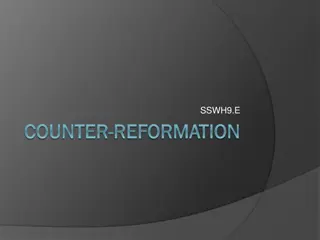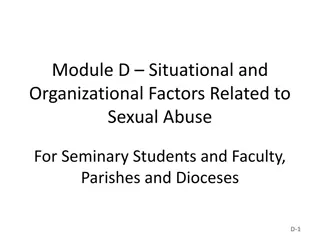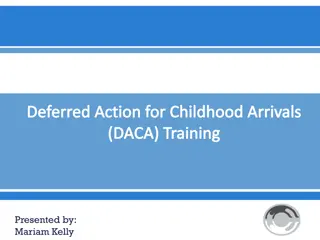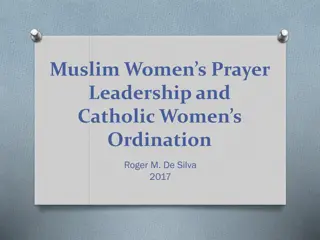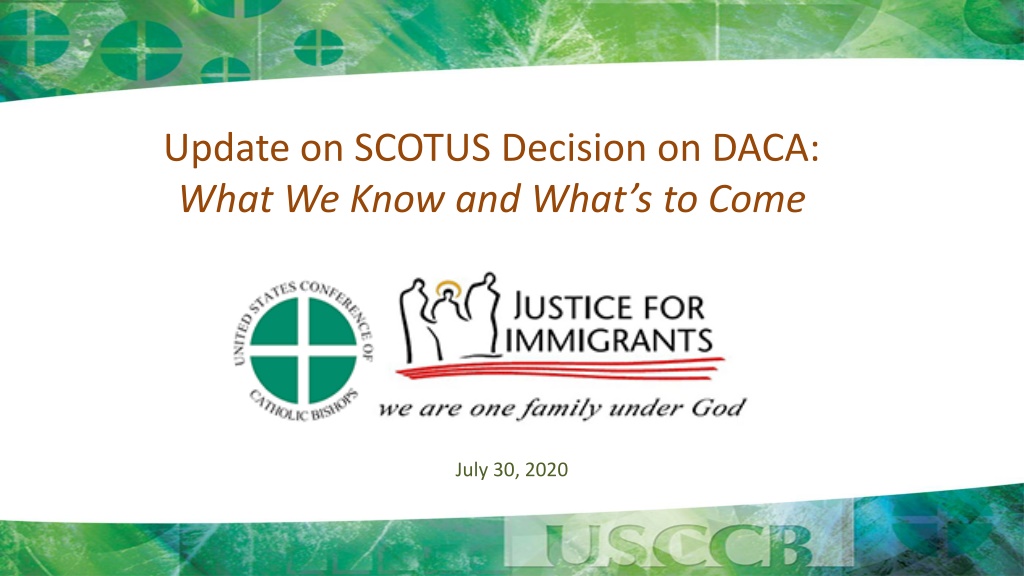
Key Takeaways from the SCOTUS Decision on DACA
"Discover the latest updates on the Supreme Court decision regarding DACA, its implications for Dreamers, and what the future holds for the program. Learn about DACA, its legal status, and the Senate's role in providing a long-term solution. Stay informed on DACA recipients' protections, renewal changes, and the ongoing call for a path to citizenship."
Download Presentation

Please find below an Image/Link to download the presentation.
The content on the website is provided AS IS for your information and personal use only. It may not be sold, licensed, or shared on other websites without obtaining consent from the author. If you encounter any issues during the download, it is possible that the publisher has removed the file from their server.
You are allowed to download the files provided on this website for personal or commercial use, subject to the condition that they are used lawfully. All files are the property of their respective owners.
The content on the website is provided AS IS for your information and personal use only. It may not be sold, licensed, or shared on other websites without obtaining consent from the author.
E N D
Presentation Transcript
Update on SCOTUS Decision on DACA: What We Know and What s to Come July 30, 2020
DACA What Is It & Timeline What is DACA? On June 15, 2012, the Secretary of DHS announced via a memorandum that certain individuals who came to the U.S. as children and met several guidelines could request consideration for deferred action through the newly initiated Deferred Action for Childhood Arrivals (DACA) program. Does DACA Provide a Path to Legalization or to Citizenship? No. DACA does not grant a path to permanent residency or citizenship. That can only be done if legislation like the DREAM Act were to be enacted into law. How Many Persons Are Currently Protected by DACA? There are approximately 700,000 individuals who currently have DACA. It is estimated, however, that there are as many as 1.3 million persons living in the U.S. who could be immediately eligible for the program. Some potential DACA recipients did not come forward because they faced obstacles such as the application fee or proof of continuous presence, while others feared giving information to DHS. What happened to DACA in September 2017? The Trump Administration attempted to end DACA on September 5, 2017. For nearly three years, the attempt to terminate DACA was the subject of litigation and multiple nationwide preliminary injunctions. November 12, 2019- the Supreme Court heard oral argument on DACA. June 18, 2020- the Supreme Court issued a ruling that has at least temporarily prevented the Administration from ending DACA in the manner they attempted in September 2017. The opinion allows new DACA recipients to apply as well. On June 19, 2020- July 26, 2020-President Trump announces he will end DACA and that he will keep DACA numerous times. July 27, 2020-Trump Administration issues memo limiting DACA program and signaling review of DACA leading to possible/likely cancellation.
Key Takeaways from the Supreme Court Decision This victory is temporary and the Senate must act for a real solution Court did not address whether the DACA policy itself is legal In a decision to end DACA, DHS must consider DACA recipient s reliance interest in the policy DHS could issue a new memo to end DACA that would satisfy the APA requirements; Also in theory the Administration could issue a memo On July 27th DHS issued a memo limiting DACA program
What Does This Mean For Dreamers? Current DACA recipients remain protected from deportation and eligible for related benefits The renewal process is changed due to July 27th memo- shortening work authorization from 2 years to 1 and no new DACA applicants The House passed the Dream Act and Promise Act in 2019 DACA recipients are now waiting on the Senate to take action for protection from deportation, and a path to citizenship
What are the challenges and opportunities with the COVID-19 pandemic? COVID-19 Presents Additional Threats to DACA Recipients - In a time of heightened uncertainty amidst the COVID-19 pandemic, 700,000 DACA recipients across the country are facing extreme, unprecedented challenges - far beyond their current day-to-day hardships. - DACA recipients across the country - nearly 90% of whom are currently employed - face the loss of their jobs, wages, and healthcare as the crisis continues. Dreamers Are Working on the Frontlines of the COVID-19 Response - DACA recipients are deeply embedded in our society and are now in the front lines of the labor force responding to pressing needs. - According to the New American Economy, 62,600 DACA-eligible individuals are currently employed in the healthcare industry nationally. - According to the Center for Migration Studies, 21,100 DACA holders work in transportation and warehousing, including 6,400 in warehousing and storage and 5,100 in truck transportation.
Our Request of Senators Pass the DREAM Act, or introduce and pass the American Dream and Promise Act Include protection from deportation of DACA & TPS recipients in the Senate s COVID-19 relief package. Why This Request? The Senate may not vote on stand-alone legislation at this time. But they are poised to advance legislation to provide more pandemic assistance and can include protection for DACA & TPS immigrants in their expected COVID-19 relief package.
What Can You Do? Learn More about Dreamers Sign up for Justice for Immigrants: https://justiceforimmigrants.org/take-action/join-us/ JFI DACA Resources Page: https://justiceforimmigrants.org/daca-resource- page/ Contact Your Senators and Urge Them To Act Send our Action Alert Make an Appointment with Your Senate Office In District Learn How You Can Support Dreamers Learn More about DACA Support Services from Ignatian Solidarity Network













